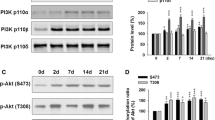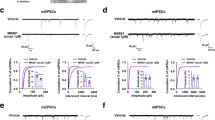Abstract
Up-regulation of GluN2B-containing N-methyl-d-aspartate receptors (NMDARs) expression and trafficking is the key mechanism for remifentanil-induced hyperalgesia (RIH), nevertheless, the signaling pathway and pivotal proteins involved in RIH remain equivocal. PKMζ, an isoform of protein kinase C (PKC), maintains pain memory storage in neuropathic pain and inflammatory pain, which plays a parallel role regulated by NMDARs in long-term memory trace. In the present study, Zeta Inhibitory Peptide (ZIP), a PKMζ inhibitor, and a selective GluN2B antagonist Ro-256981 are injected intrathecally before remifentanil infusion (1 μg kg−1 min−1 for 1 h, iv) in order to detect whether GluN2B contributes to RIH through affecting synthesis and activity of PKMζ in spinal dorsal horn. Nociceptive tests are measured by Paw withdrawal mechanical threshold (PWT) and paw withdrawal thermal latency (PWL). The L4–L6 segments of dorsal horn taken from rats with RIH are for determining expression of PKMζ and pPKMζ by Western blot and immunohistochemistry. Our data suggest that remifentanil infusion causes an increase of PKMζ in expression and phosphorylation in rats with nociceptive sensitization, beginning at 2 h, peaked at 2 days, and returned to basal level at 7 days. ZIP (10 ng) could block behavioral sensitization induced by remifentanil. Ro25-6981 dosage-dependently attenuated mechanical and thermal hyperalgesia and reversed expression of PKMζ and pPKMζ, indicating that GluN2B-containing NMDA receptor facilitates development of RIH through mediating expression and activity of spinal PKMζ in rats. Although detailed mechanisms require further comprehensive study, the preventive role of Ro25-6981 and ZIP provide novel options for the effective precaution of RIH in clinics.








Similar content being viewed by others
Abbreviations
- NMDARs:
-
N-methyl-d-aspartate receptors
- RIH:
-
Remifentanil-induced hyperalgesia
- PKC:
-
Protein kinase C
- ZIP:
-
Zeta inhibitory peptide
- PWT:
-
Paw withdrawal mechanical threshold
- PWL:
-
Paw withdrawal thermal latency
References
Andre L, Mark HP, Anne H, Yue H, Virginia C (2011) PKM ζ is essential for spinal plasticity underlying the maintenance of persistent pain. Mol Pain 7:99
Angst MS, Koppert W, Pahl I, Clark DJ, Schmelz M (2003) Short-term infusion of mu-opioid agonist remifentanil in humans causes hyperalgesia during withdrawal. Pain 106:49–57
Asiedu MN, Tillu DV, Melemedjian OK, Shy A, Sanoja R, Bodell B, Ghosh S, Porreca F, Price TJ (2011) Spinal protein kinase M zeta underlies the maintenance mechanism of persistent nociceptive sensitization. J Neurosci 31(18):6646–6653
Bornemann-Cimenti H, Lederer AJ, Wejbora M, Michaeli K, Kern-Pirsch C, Archan S (2012) Preoperative pregabalin administration significantly reduces postoperative opioid consumption and mechanical hyperalgesia after transperitoneal nephrectomy. Br J Anaesth 108:845–849
Celerier E, Gonzalez JR, Maldonado R, Cabañero D (2006) Opioid-induced hyperalgesia in a murine model of postoperative pain. Anesthesiology 104:546–555
Céline H, Ruth DS, Dimitris NX, Jürgen S (2011) Distinct mechanisms underlying pronociceptive effects of opioids. J Neurosci 31(46):16748–16756
Chizh BA (2007) Low dose ketamine: a therapeutic and research tool to explore N-methyl-d-aspartate (NMDA) receptor-mediated plasticity in pain pathways. J Psychopharmacol 21:259–271
Chu LF, Angst MS, Clark D (2008) Opioid-induced hyperalgesia in humans: molecular mechanisms and clinical considerations. Clin J Pain 24:479–496
Crain SM, Shen KF (2000) Antagonists of excitatory opioid receptor functions enhance morphine’s analgesic potency and attenuate opioid tolerance/dependence liability. Pain 84:121–131
Derrode N, Lebrun F, Levron JC, Chauvin M, Debaene B (2003a) Influence of reoperative opioid on postoperative pain after major abdominal surgery: sufentanil TCI versus remifentanil TCI. A randomized, controlled study. Br J Anaesth 91:842–849
Derrode N, Lebrun F, Levron JC, Chauvin M, Debaene B (2003b) Influence of preoperative opioid on postoperative pain after major abdominal surgery: sufentanil TCI versus remifentanil TCI. A randomized, controlled study. Br J Anaesth 93:409–417
Drdla R, Gassner M, Gingl E,
 J (2009) Induction of synaptic long-term potentiation after opioid withdrawal. Science 325(5937):207–210
J (2009) Induction of synaptic long-term potentiation after opioid withdrawal. Science 325(5937):207–210Gu X, Wu X, Liu Y, Cui S, Ma Z (2009) Tyrosine phosphorylation of the N-methyl-d-aspartate receptor 2B subunit in spinal cord contributes to remifentanil-induced postoperative hyperalgesia: the preventive effect of ketamine. Mol Pain 5:76
Jiang M, Zhang W, Ma ZL, Gu XP (2013) Antinociception and prevention of hyperalgesia by intrathecal administration of Ro 25-6981, a highly selective antagonist of the 2B subunit of N-methyl-d-aspartate receptor. Pharmacol Biochem Behav 112:56–63
Kelly MT, Crary JF, Scaktor TC (2007) Regulation of protein kinase Mzeta synthesis by multiple kinases in long-term potentiation. J Neurosci 27:3439–3444
King T, Qu C, Okun A, Melemedjian OK, Mandell EK, Maskaykina IY, Navratilova E, Dussor GO, Ghosh S, Price TJ, Porreca F (2012) Contribution of PKM-zeta dependent and independent amplification to components of experimental neuropathic pain. Pain 153(6):1263–1273
Kissin I, Lee SS, Arthur GR, Bradley EJ (1996) Time course characteristics of acute tolerance development to continuously infused alfentanial in rats. Anesth Analg 83:600–605
Klaus H, Joke N, Hugo K, Buerkle H, Halene T, Schauerte S (2004) Remifentanil directly activates human N-methyl-d-aspartate receptors expressed in Xenopus laevis oocytes. Anesthesiology 100:1531–1537
Koppert W, Schmelz M (2007) The impact of opioid-induced hyperalgesia for postoperative pain. Best Pract Res Clin Anaesthesiol 21:65–83
Lee M, Silverman SM, Hansen H, Patel VB, Manchikanti L (2011) A comprehensive review of opioid-induced hyperalgesia. Pain Physician 14:145–161
Li XY, Ko HG, Chen T (2010) Alleviating neuropathic pain hypersensitivity by inhibiting PKM zeta in the anterior ingulated cortex. Science 330(6009):1400–1404
Li Y, Wang H, Xie K, Wang C, Yang Z, Yu Y, Wang G (2013) Inhibition of glycogen synthase kinase-3β prevents remifentanil-induced hyperalgesia via regulating the expression and function of spinal N-methyl-d-aspartate receptors in vivo and vitro. PLoS ONE 8(10):e77790
Liang DY, Li X, Clark JD (2011) 5-Hydroxytryptamine type 3 receptor modulates opioid-induced hyperalgesia and tolerance in mice. Anesthesiology 114:1180–1189
Rivosecchi RM, Rice MJ, Smithburger PL, Buckley MS, Coons JC, Kane-Gill SL (2014) An evidence based systematic review of remifentanil associated opioid-induced hyperalgesia. Expert Opin Drug Saf 13(5):587–603
Sacktor TC (2011) How does PKM ζ maintain long-term memory? Nat Rev Neurosci 12(1):9–15
Sadeh N, Verbitsky S, Dudai Y, Seqal M (2015) Zeta inhibitory peptide, a candidate inhibitor of protein kinase Mζ, is excitotoxic to cultured hippocampal neurons. J Neurosci 35(36):12404–12411
Shema R, Haramati S, Ron S, Hazvi S, Chen A, Sacktor TC, Dudai Y (2011) Enhancement of consolidated long-term memory by overexpression of protein kinase Mζ in the neocortex. Science 331(6021):1207–1210
Størkson RV, Kjørsvik A, Tjølsen A, Hole K (1996) Lumbar catheterization of the spinal subarachnoid space in the rat. J Neurosci Methods 65:167–172
Sullivan JP, Connor JR, Shearer BG, Burch RM (2002) 2,6-Diamino-N-([1-(1oxotridecyl)-2-piperidinyl] methyl)hexanamide (NPC 15437), a novel inhibitor of protein kinase C interacting at the regulatory domain. Mol Pharmacol 41:38–44
Todd CS (2012) Memory maintenance by PKM ζ-an evolutionary perspective. Sacktor Mol Brain 5:31
Von Engelhardt J, Coserea I, Pawlak V, Fuchs EC, Seeburg PH, Monyer H (2007) Excitotoxicity in vitro by NR2A- and GLUN2B-containing NMDA receptors. Neuropharmacology 53:10–17
Wider-smith OH, Arendt-Nielsen L (2006) Postoperative hyperalgesia: its clinical importance and relevance. Anesthesiology 104:106–107
Yuan Y, Wang JY, Yuan F, Xie KL, Yu YH, Wang GL (2013) Glycogen synthase kinase-3β contributes to remifentanil-induced postoperative hyperalgesia via regulating N-methyl-d-aspartate receptor trafficking. Anesth Analg 116(2):473–481
Zhang LL, Shu RC, Wang HY, Yu YH, Wang CY, Yang M, Wang M, Wang GL (2014) Hydrogen-rich saline prevents remifentanil-induced hyperalgesia and inhibits MnSOD nitration via regulation of GLUN2B-containing NMDA receptors in rats. Neuroscience 280:171–180
Zhao M, Joo DT (2008a) Enhancement of spinal N-methyl-d-aspartate receptor function by remifentanil action at delta-opioid receptors as a mechanism for acute opioid-induced hyperalgesia or tolerance. Anesthesiology 109(2):308–317
Zhao M, Joo DT (2008b) Enhancement of spinal N-methyl-D-aspartate receptor function by remifentanil action at delta-opioid receptors as a mechanism for acute opioid-induced hyperalgesia or tolerance. Anesthesiology 109(2):308–317
Acknowledgments
This work was supported by research grants from the National Natural Science Foundation of China (81571077, 81371245, 81301025, and 81400908) and Science and Technology Supported Key Project of Tianjin (12ZCZDSY03000).
Author contribution
Qi Zhao helped design the study, conduct the study, analyze the data, and write the manuscript. Linlin Zhang helped design the study, conduct the study, and analyze the data. Ruichen Shu helped conduct the study and analyze the data. Chunyan Wang and Haiyun Wang helped design the study and analyze the data. Yonghao Yu helped conduct the study. Guolin Wang helped design the study, analyze the data, and write the manuscript.
Author information
Authors and Affiliations
Corresponding author
Ethics declarations
Conflict of Interest
The authors declare no conflict of interest.
Rights and permissions
About this article
Cite this article
Zhao, Q., Zhang, L., Shu, R. et al. Involvement of Spinal PKMζ Expression and Phosphorylation in Remifentanil-Induced Long-Term Hyperalgesia in Rats. Cell Mol Neurobiol 37, 643–653 (2017). https://doi.org/10.1007/s10571-016-0401-0
Received:
Accepted:
Published:
Issue Date:
DOI: https://doi.org/10.1007/s10571-016-0401-0





 J (2009) Induction of synaptic long-term potentiation after opioid withdrawal. Science 325(5937):207–210
J (2009) Induction of synaptic long-term potentiation after opioid withdrawal. Science 325(5937):207–210